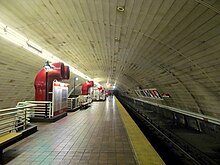History

Glove Cycle was created as a part of the MBTA and the Cambridge Arts Council's "Arts on the Line" program. This first of its kind program was devised to bring art into the MBTA's planned Northwest Extension of the Red Line subway stations in the late 1970s and early 1980s, and became a model for similar drives for public art across the country. [5] This installation was one of 20 artworks created for this program, out of over 400 proposals submitted by artists [6] for artworks spread out across five different newly created subway stations. The first 20 artworks, including this one, were completed with a total cost of $695,000 USD, or one-half of one percent of the total construction cost of the Red Line Northwest Extension. [5] The cost of this particular sculpture was $30,000. [1]
Gloves was not the first theme that Harries considered for her subterranean artwork. Initially her concept revolved around bronze tree roots appearing to come through the walls and into the stations. This idea was turned down by the architects of Porter Station for bringing attention to the fact that the station is deep underground. Harries stated, "The whole philosophy of subway stations, it turns out, is to make them seem as un-underground as possible," something the tree roots idea would be the exact opposite of. [3] The next theme she considered was to create a flock of sheep-shaped turnstiles. This concept fell to the wayside as the snow from a blizzard in Boston began to melt. Harries began to find lost gloves emerging from the snow. She said that, "They were wet, compacted, squashed—really beautiful!" [3] These lost items gave her the inspiration for her new sculptural theme, gloves. [3]
Three of the gloves were stolen during the sculpture's first decade by vandals who broke them out of walls. [7]